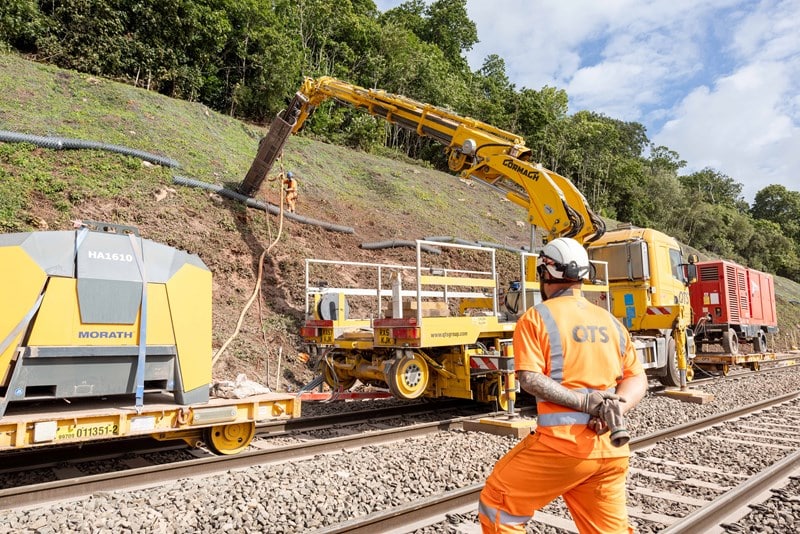The Severn Estuary line has today (Friday 18 August) reopened after three weeks of 24/7 work to mitigate the impact of weather-related landslips that will improve train performance, reduce delays, and ensure the highest level of reliability for passengers and freight services.
More than 100 engineers from Network Rail and principal contractor, AmcoGiffen, along with their strategic partner QTS Group worked around the clock, from Monday 31 July to Friday 18 August, to install an ‘active’ mesh system on the cliffs overlooking the exposed railway between Monmouthshire and Gloucestershire.
The teams worked more than 34,000 hours, with trained specialist rope access technicians abseiling down the cliff face, removing 1,000 tonnes of loose material before securing the specially designed netting with 5,000 rock bolts.
This bespoke ‘active’ system will hold the cliff face in position and help to prevent landslips from damaging, and subsequently, closing the railway.

Part of a wider multi-million-pound investment, this work demonstrates Network Rail’s commitment to boosting resilience and mitigating the impacts of climate change on the Wales and Borders route.
This section of railway was hit by three landslips in January 2023 alone, following a bout of prolonged heavy rainfall, which has led to a huge financial and disruptive impact.
To safely run trains following the recent landslips, Network Rail imposed a temporary speed restriction (TSR) of 20mph – reduced from the normal line speed of 75mph. This has caused nearly 6,000 delay minutes, costing more than £400,000 of taxpayers’ money.
The completion of this next phase means the TSR can now be removed, improving journey times and reducing costs to the taxpayer.
Phase one of this project was completed last summer and has also had huge benefits.
”We are dedicated to improving resilience across the Wales & Borders route and we’re already seeing the benefit this multi-million-pound investment is having on the Severn Estuary line. The new mesh installed on a different section of the cliff, last Summer, has had zero landslips that have impacted the railway.
With Phase Two now complete, the whole line is better protected against severe weather events. We will be coming back to carry out more resilience work to further future proof this line against the challenging effects of climate change.
I would like to thank passengers and the local community for their patience while we carried these vital improvements.
Nick Millingtonroute director for Network Rail Wales & Borders
”We know how important our rail infrastructure is to passengers and freight and we’re delighted to have safely and successfully achieved our targets during this blockade.
Working diligently alongside our sister company QTS Group, we’ve completed this crucial phase of the essential Severn Estuary Resilience Programme with the cutting slope stabilisation, handing back the blockade on time, as planned.
This project showcases our commitment to collaboration, excellence and innovation to ensure journey efficiency and reliability for customers with a minimum impact for our lineside neighbours.
Andy Crowleyoperation director for Wales & Borders at AmcoGiffen
”The effort that our team has put into ensuring the success of these works at the Severn Estuary is something to be proud of.
Being able to utilise the very best in rail plant innovation has allowed us to deliver these works on time, and as efficiently as possible, working in partnership with AmcoGiffen for Network Rail.
We are pleased to have managed to carry out these works with minimal disruption for our lineside neighbours and thank them for their patience during the period of works.
Gary BurnettOperations Director for QTS
Network Rail and contractors will remain on site on the Severn Estuary to install more bolts and mesh until March 2024. This work will not be disruptive to rail services.
Designs and plans for the next stage of this resilience project are currently being finalised, with teams expected to return next year to upgrade Phase One’s ‘passive’ system – that catches debris rather than holds it in place – with an ‘active’ system.


















